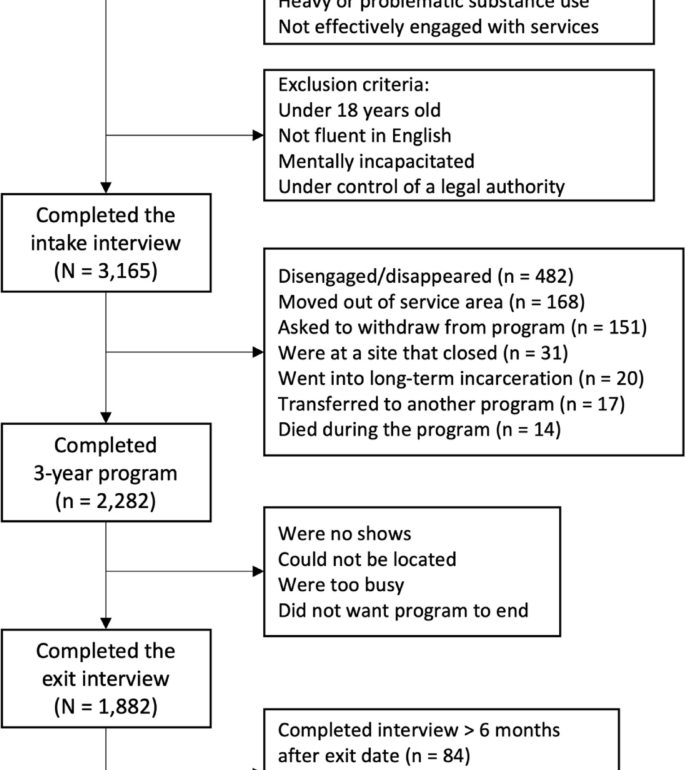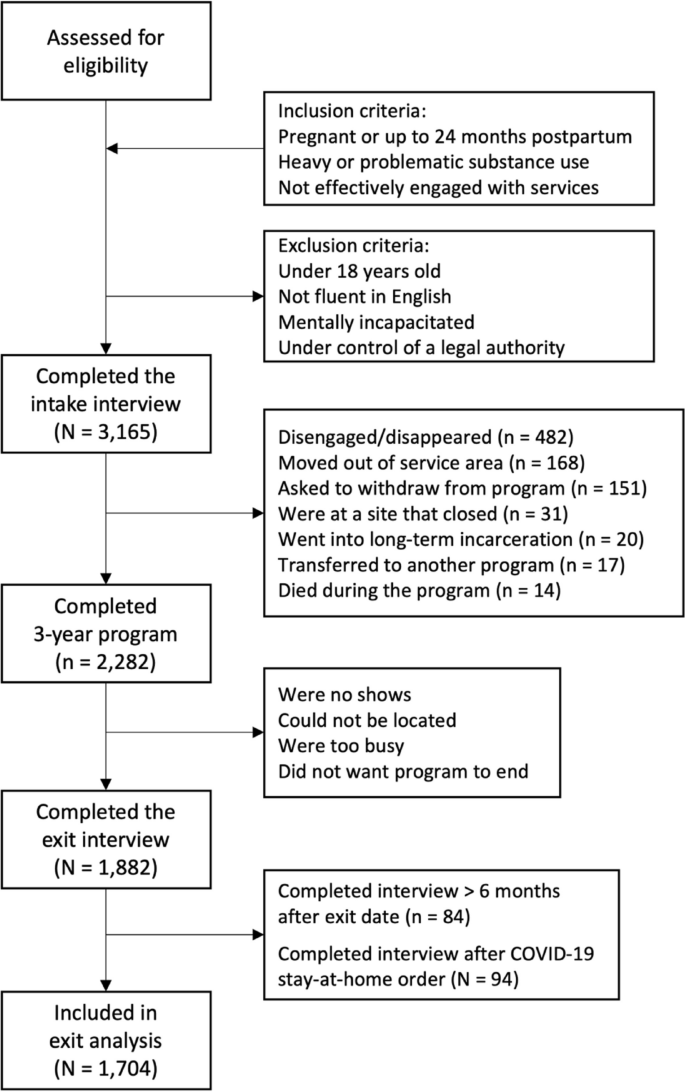The Washington State Institutional Review Board fully reviewed and approved (D-030310) the study protocol. All participants provided informed, signed consent for their data to be used for research purposes. All methods were carried out in accordance with relevant guidelines and regulations.
Participants
We examined data for all consenting participants who enrolled in PCAP in Washington State between May 10, 2006, and September 21, 2017. The cutoff point was selected to exclude participants whose three-year exit data could have been affected by the COVID-19 pandemic. During the chosen timeframe, a total of 3,165 eligible women were enrolled at twelve program sites serving fifteen Washington counties, completed an intake interview in which they reported their race and ethnicity and consented for their data to be used for research. Inclusion and exclusion criteria are shown in Fig. 1. Most participants were referred by community providers (e.g., child welfare workers, SUD treatment providers) who were familiar with the intervention (through brochures, presentations, and word of mouth).
Analysis sample
Figure 1 shows the flow of participants through the program and the study. Of the 3,165 participants, 883 (27.9%) did not complete the program because they disengaged or disappeared (n = 482), moved out of the area (n = 168), withdrew from the program (n = 151), died (n = 14), went into long-term incarceration (n = 20), transferred to another program (n = 17), or were at a site that closed (n = 31). An additional 400 mothers (12.6%) were enrolled in PCAP for three years but did not provide data for an exit interview (were no-shows, could not be located, were too busy, or did not want to end PCAP). Data for 178 women (5.6%) were excluded from the analysis of the exit data because, though they exited the program, they completed their exit interview either more than six months after their target exit date (n = 84) or after the governor’s Stay-at-Home order to address the COVID-19 pandemic on March 23, 2020 (n = 94). Data from the remaining 1,704 were included in the analysis of the outcome data.
Interviewers
Intake interviewers were PCAP clinical supervisors, all of whom had extensive experience working with diverse women. Exit interviewers were trained research assistants who did not have contact with participants during the intervention. All interviewers used detailed instruction manuals (available upon request) and were trained by an expert in the Addiction Severity Index to standards designed to ensure consistent interview procedures and enhance the reliability and validity of the data.
Measures
Demographics
The following demographics were assessed as part of the Addiction Severity Index [18] interview, described in further detail below: age (number of years, calculated from date of birth), race and ethnicity (select all that apply), marital status, employment status, housing status, education (number of years), and household income (dollars per month). We also recorded whether they were enrolled at site in a rural or urban county according to state guidelines [19].
Racial/ethnic categorization
Our analysis was based upon the reporting standard of the Washington State Department of Children, Youth and Families (DCYF) for advancing racial equity [20]. The WSRDAC/M Reporting Standard combines racial and ethnic (Hispanic/Latino) identifications into a single race/ethnicity categorical variable. Reflecting the degree of disparities generally observed in the child welfare system, individuals with more than one racial/ethnic identifier are hierarchically assigned (depending on the particulars) to the American Indian/Alaska Native (abbreviated AI/AN), African American/Black (abbreviated Black), or Hispanic/Latino (abbreviated Hispanic) “multiracial” WSRDAC/M categories. Procedurally, participants with any identification as American Indian/Alaska Native are categorized as such; then any remaining participants with any identification as Black/African American are categorized as such; and then any remaining participants with any identification as Hispanic/Latino are categorized as such. Finally, any remaining multiracial participants would have identified as Asian/Pacific Islander and are categorized as such. As a result, only the White category does not include any multiracial participants [20]. For analysis purposes, rather than use a polytomous race/ethnicity variable, we created four dichotomous variables that reflected membership in each of the minoritized groups.
Addiction severity index
At program intake and exit, we interviewed participants with the Addiction Severity Index (ASI), 5th edition, [18, 21] a widely used standardized, semi-structured interview nstrument with well-supported reliability and validity [22]. It assesses medical, employment/support, alcohol, drug, legal, family/social, and psychiatric domains. These domains are of interest because they may have a significant impact on participants’ ability to benefit from the program and may differ by race and ethnicity at program intake. We created a dichotomous indicator of illicit drug use within the past 30 days at exit that excluded use of alcohol, cannabis, and prescription drugs used as prescribed.
Supplemental questions for pregnant and postpartum women
We developed supplemental items, worded by subject matter experts in a straightforward manner, to assess drug use during pregnancy, reproductive history, and adverse life experiences not assessed in the ASI and administered them in conjunction with the intake ASI. The substances assessed were the same as those in the standard ASI: alcohol, heroin, methadone, other opiates/analgesics, barbiturates, other sedatives/tranquilizers, cocaine, amphetamines, cannabis, hallucinogens, and inhalants. We created a dichotomous variable for each substance to indicate whether it was used during pregnancy (or the month prior) and an indicator of illicit drug use that excluded use of alcohol, cannabis, and prescription drugs. We included an indicator of binge alcohol use, defined as ≥ 4 standard drinks per occasion [23]. Questions about reproductive history assessed birth control use (no use, sporadic use, or regular use), the number of the participant’s biological children and, of those, the number not living with the participant. Questions about adverse life experiences asked whether the participant’s natural mother drank alcohol while she was pregnant with the participant and whether child protective services were involved when the participant was growing up.
Recovery supports/community services
At PCAP intake and at exit, participants were asked to identify services they had received in the preceding year. Services assessed included those related to healthcare provision for mother and child(ren), family planning, mental health, housing, emergency funds, food/clothing/supplies, legal aid, domestic violence, childcare, support groups, public schools, and public health nursing. Each service was coded as to whether the client herself expressed a need for that service (Yes = 1/No = 0) and whether the service was received (Yes = 1/No = 0). For each participant, a service ratio was calculated as the sum of the number of services reported as received divided by the sum of the number reported as needed. A ratio of one indicates that all needs were met, including any who reported no needs and thus had no unmet needs.
Case manager time spent
On a weekly basis (i.e., a seven-day period), case managers recorded the amount of time spent working directly with or on behalf of each participant. We calculated a summary score for direct time by summing the number of contact hours with the CM during the intervention (including face-to-face meetings, time spent transporting the participant, and phone communication with the participant), as well as a summary score for “other” time spent working on a participant’s case (i.e., without the participant present), which is the sum of time spent working with an agency on behalf of the participant, time spent with participant’s family, and time spent corresponding with the participant.
Data analytic approach
All descriptive analyses were based solely on the responses provided. We generated intake descriptive bivariate results using IBM® SPSS® Statistics version 28.0, examining family composition, maternal characteristics (demographic and psychosocial), and community services (needed) variables by participant race/ethnicity (as defined above). With one exception, to examine nominal variables we used the Fisher-Freeman-Halton Exact Test to examine nominal variables. The exception (necessary for computational reasons) was the urban/rural site indicator, for which we referred to the Pearson Chi-Square test result. Post-hoc, we used cell-specific adjusted standardized residuals to gauge each individual cell’s contribution to the statistically significant result. For testing differences of the means of continuous variables across the race/ethnicity groups we entered (as a fixed set) four race/ethnicity indicators (using White as the reference category) into a regression equation and determined statistical significance of each race/ethnicity indicator by reference to the t-tests of their regression coefficients. As these tests were for descriptive purposes, rather than hypothesis testing, we made no correction for multiple tests, and all tests were two tailed (with p < .05).
In considering possible limits to the study’s generalizability, we conducted bivariate tests for the same set of family/maternal/service variables, again using the Fisher-Freeman-Halton Exact Test, but for this analysis we examined them by a categorical variable including three study groups: (1) Attrition Group (N = 852), (2) Exited with No Interview Group (N = 400), and (3) Outcome Group (N = 1,704). We did not include in this analysis participants whose site closed while they were in the program (N = 31) or whose exit interview was more than six months beyond their target interview date (N = 178).
We conducted an attrition analysis for two reasons: to consider whether exit outcomes may have been biased by who remained in the study and to examine whether there were racial/ethnic differences in intervention completion. As the first part of the attrition analysis, primarily with the purpose of screening variables into a logistic regression that was to follow (given the large number of variables involved), we conducted the same procedure as in the preceding paragraph but included only the Attrition and Outcome groups (N = 2,556). The second part of the attrition analysis used binary logistic regression with listwise deletion, including as candidate predictors the variables screened in by the prior step, to determine (now in a multivariable context) the variables significantly associated with Outcome Group membership as the outcome. We used the Backward Entry Likelihood Ratio (LR) Method and tested to see whether the resulting final model was the same if we used the Forward Entry LR Method instead.
For participants with exit data, we used Fisher-Freeman-Halton Exact Tests and t-tests of regression coefficients to examine bivariate associations of participant race/ethnicity with PCAP case manager time spent on case, participant’s child welfare/criminal justice involvement, SUD treatment received (at any time during PCAP), and other services needed and received (both during the final year of PCAP), as well as the ratio of services received to services needed. Finally, using the same methods, we examined participant outcomes by participant race/ethnicity.



